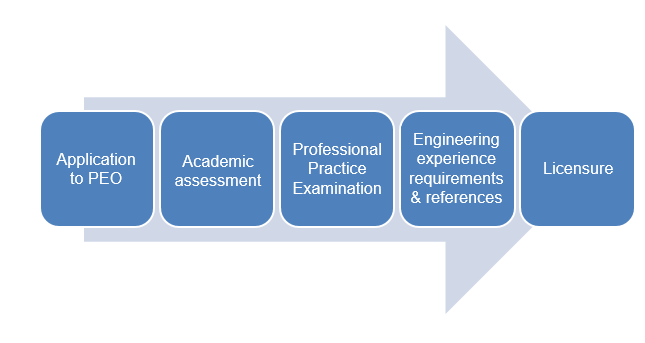With a pulse on the most pressing societal issues at hand, we know that engineers play a vital role in the daily functioning of communities and countries all over the world. It is the knowledge and technical expertise of engineers that can solve our most complex challenges – from climate change, to sustainable infrastructure, agriculture and fuels.
But what does it mean to be an engineer in Ontario?
Having an accredited engineering degree is only one of the required steps to become a Professional Engineer in Ontario. Being an “engineer” means that an individual has their engineering licence – referred to as a P.Eng. designation.
While OSPE is the advocacy association working to advance the professional and economic interests of Ontario’s engineering community by advocating with governments, employers and the public, Professional Engineers Ontario (PEO) is the official regulatory body responsible for issuing engineering licences across the province.
Why is it important to get your P.Eng. designation?
- Having your P.Eng. assures employers, clients and the general public that you have met the highest standards for educational competency, adhere to a strict code of ethics, and have acquired a minimum of 48 months of acceptable, hands-on engineering work.
- You must have a licence to be held legally and ethically responsible for your work as an engineer in Ontario. Without your P.Eng., you cannot legally sign off on your own work or certify plans without the supervision of a Professional Engineer who will assume responsibility for your work.
- As a P.Eng. you can participate in professional self-regulation via PEO, influencing the way engineering is practiced in Ontario. As a P.Eng., you have the ability to participate in one of 36 PEO Regional Chapters, and/or on one of the many PEO committees and task forces, which together perform the work of the association. Of course, as an OSPE member, you can also take a lead role in efforts to influence government policy planning via participation on OSPE’s advocacy committees or task forces, or by becoming a representative on OSPE’s Political Action Network.
- As a P.Eng., your licence serves as reassurance that you recognize and embrace your responsibility to regard the welfare of the public as paramount, and as prioritized above obligations to your clients or employer.
There are four basic steps required to obtain your P.Eng. licence in Ontario:
- Application to PEO: After obtaining a degree from an accredited engineering program, you submit an application to PEO
- Academic assessment: PEO will conduct an academic audit and will notify you if you must take any technical exams to ensure that your skills meet provincial standards
- Professional Practice Examination: This exam will test your knowledge on the Canadian legal system and the engineers’ Code of Ethics
- Preparing your Engineering Experience Record: Registering as an Engineering Intern (EIT) in PEO’s EIT program is the easiest way to ensure that you are on the right track to acquiring your necessary 48 months of acceptable engineering work experience
OSPE offers a number of P.Eng. designation resources and courses designed to help you navigate licensure, including:
- Free webinars that walk you through the stages of licensure
- PEO technical exam prep courses to enhance your knowledge in a variety of sector-specific fields
- Prep courses for the Professional Practice Exam, which covers exam topics and methods of approach for the various types of questions
- Workshops and coaching sessions for composing your Engineering Experience Record
When you become an engineering licence holder in Ontario, you join a community of over 80,000 professionals who have dedicated their careers to improving the quality of life for all Ontarians.
Find out more about the obtaining a P.Eng. licence in Ontario and register for any of OSPE’s P.Eng. designation courses today!








As member of OSPE since inception, I find it problematic when I see statements that OSPE is the advocacy association working to advance the professional and economic interests of Ontario’s “engineering community”. Does the Ontario Bar Association advocate for everyone in the Legal Community which include Law Clerks, Stenographers & Administrators? Of course not. The OMA advocates only for those who have a license to practice law. Does the Ontario Medical Association advocate for all those working in the Medical Community including Nurses, Lab Techs, Respiratory Technologists, etc? Again, No. The OMA advocates only for their members who are licensed Physicians & Surgeons. By advocating for “the engineering community” it seems as if OSPE is evolving into an “Engineering” industry association which is clearly a move away from it’s original mandate when OSPE was formed 16 years ago by PEO. OSPE or the Ontario Society of “Professional Engineers” was created to be the advocacy body for Professional Engineers, full stop. A move away from OSPE’s original mandate is a conflict of interest and decreases the value proposition of my OSPE membership as a Professional Engineer.
Thank you for your comment. OSPE has four distinct membership categories – Professional (P.Eng.), Associate (engineering graduate), Intern (Engineering Intern) and Student (enrolled in an accredited post secondary engineering program). We support the thousands of engineering graduates who are trying to obtain their P.Eng. licence and would like to provide a voice for them as well. Our mandate, which was affirmed by our Board of Directors in our most recent Strategic Plan, is to represent the entire engineering community, which includes all members in all four categories.
OSPE is able to successfully promote the profession as a whole – while describing what it means to be a P.Eng. in Ontario and why engineers must be involved in public policy – as demonstrated with our recent #AnEngineerWasHere campaign. Various members of the engineering community also participated, to the benefit of the entire profession. At OSPE, we believe diversity and inclusivity makes us stronger. To distinguish the differences between OSPE and PEO, please visit our “Two Sides of the Same Coin” brochure, developed jointly by OSPE and PEO.
Notwithstanding the staff response, I agree whole-heartedly with Ms Spinks’ comments. I suspect the public might be surprised to find the ‘engineering community’ doesn’t include everybody – licensed or otherwise – who performs something that somehow involves engineering … and that’s a far cry from a group exclusively made up of professional engineers and graduates on a licensure track.
As mentioned above, OSPE is guided by its five-year Strategic Plan, which states that the Society is the only association in Ontario with the mandate to represent the entire engineering community. We believe this is our greatest strength. We have the numbers, and with your engagement, a strong voice to influence decisions that will have a profound impact on the profession and the day-to-day lives of all Ontarians.
It’s interesting to note a recent viewpoint in Engineering Dimensions May/June 2016 issue, “The 70 per cent problem, the 30 per cent solution” which points out that since the majority of P.Eng.s are in fact non-practising, the identity of a professional engineer is already confusing to the public.
“As far as the public is concerned, the members of PEO that the public runs across are doing the same job as they, the public, are. That is, PEO members are teachers, lawyers, real estate agents, financial analysts/advisors, insurance adjusters, accountants, administrators or managers. So as far as the public is concerned, why should a non-practising member of PEO get any more remuneration or recognition than a public individual doing the same job?
As radical as it may sound, and as difficult as it may be to implement, the solution to all of these issues is to restrict PEO membership to the 30 per cent who need to be licensed professional engineers. In this way, PEO can truly fulfill its mandate under the act, which will allow PEO to best serve the public interest.
The secondary consequence of properly restricting membership to only practising engineers is that it will eventually allow the public to see that professional engineers do things that the general public cannot do, in the same way that the public sees that teachers, lawyers and accountants do things that the general public cannot.”
While OSPE has no comment on the above perspective, we need to reiterate that OSPE and PEO are two different organizations with two very unique and distinct mandates. PEO is about regulating the profession and OSPE’s mandate is to promote engineers and engineering.
One of OSPE’s strategic goals – to engage the entire engineering community – is, in part, meant to promote the value of the engineering perspective and the problem solving and critical thinking skills that come with the education. Thus, we also work with engineering students, faculty, and all engineering graduates who possess these skills, in order to get them involved in the public policy discussion, as well as to encourage them to pursue licensure if they are eligible.
Pingback: How can international engineering grads adapt their skills for a career in Ontario's environment sector? • Ontario Society of Professional Engineers